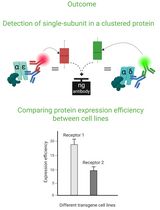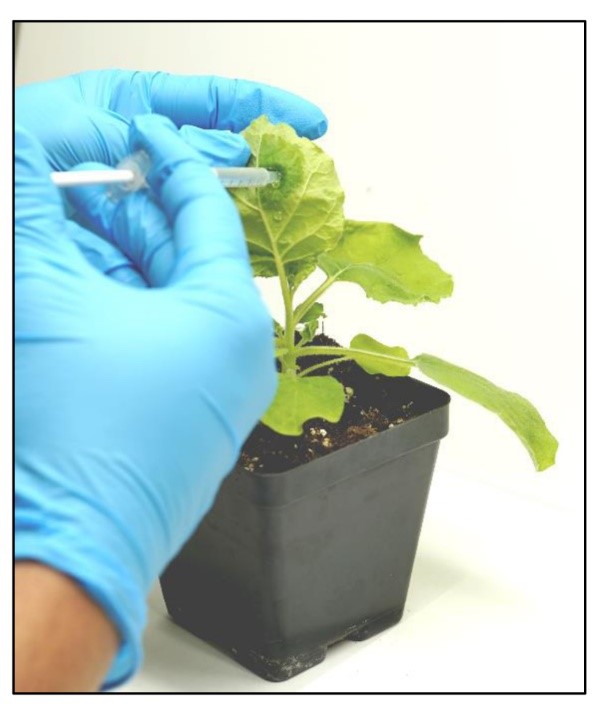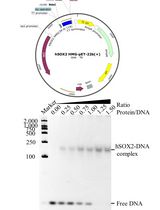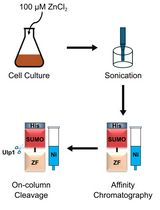- EN - English
- CN - 中文
Simplified Protocol to Demonstrate Gene Expression in Nicotiana benthamiana Using an Agrobacterium-Mediated Transient Assay
利用根癌农杆菌介导的瞬时测定法在烟草中展示基因表达的简化方案
发布: 2024年05月20日第14卷第10期 DOI: 10.21769/BioProtoc.4987 浏览次数: 2242
评审: Samik BhattacharyaAnonymous reviewer(s)

相关实验方案

Cluster FLISA——用于比较不同细胞系蛋白表达效率及蛋白亚基聚集状态的方法
Sabrina Brockmöller and Lara Maria Molitor
2025年11月05日 150 阅读
Abstract
Agrobacterium-mediated transient gene expression in Nicotiana benthamiana is widely used to study gene function in plants. One dramatic phenotype that is frequently screened for is cell death. Here, we present a simplified protocol for Agrobacterium-mediated transient gene expression by infiltration. Compared with current methods, the novel protocol can be done without a centrifuge or spectrometer, thereby suitable for K-12 outreach programs as well as rapidly identifying genes that induce cell death.
Key features
• The protocol simplifies the widely used Agrobacterium-mediated transient gene expression assay [1] and can be completed within one week when plants are available.
• Rice XB3 gene can induce a dramatic and easily identifiable cell death phenotype in Nicotiana benthamiana.
• Allows identification of cell death–inducing genes and is suitable for teaching.
• Compared to the currently used methods, our protocol omits the use of agroinfiltration buffer, pH meter, temperature-controlled growth chamber, centrifuge, and spectrophotometer.
Keywords: Agrobacterium (根癌农杆菌)Graphical overview
 Agrobacterium infiltration (agroinfiltration) of Nicotiana benthamiana. The photo demonstrates the method of agroinfiltration into the abaxial side of leaves using a needleless syringe.
Agrobacterium infiltration (agroinfiltration) of Nicotiana benthamiana. The photo demonstrates the method of agroinfiltration into the abaxial side of leaves using a needleless syringe.
Background
Agrobacterium-mediated transient transformation of the plant Nicotiana benthamiana is a powerful tool widely used in molecular biology studies [2,3]. This assay is ideal for rapidly demonstrating gene expression, especially when used for the visible cell death phenotype induced by specific plant genes from various species. While holding summer professional development workshops for pre-college educators, we found that the current protocols for Agrobacterium-mediated transient gene expression are difficult to use in pre-college classrooms due to lack of the necessary equipment and reagents.
The rice (Oryza sativa) cell surface innate immune receptor XA21 specifies resistance to bacterial strains of Xanthomonas oryzae pv. oryzae [4]. XA21 interacts with a number of proteins in vitro and in vivo. One protein that XA21 interacts with is called XB3 for XA21 binding protein 3 [5]. XB3 induces highly visible cell death in N. benthamiana when over-expressed [1]. To support public education and quickly identify cell death–inducing genes, we developed a novel protocol to simplify the current Agrobacterium-mediated transient gene expression assay.
Materials and reagents
N. benthamiana seeds (available from numerous plant science research labs)
pC1300S-XB3: Agrobacterium tumefaciens strain EHA105 (Intact Genomics, catalog number: 1084-06) harboring the construct pC1300S-XB3 [1]
EV: A. tumefaciens strain EHA105 harboring pC1300S (empty vector)
P19: A. tumefaciens carrying the p19 construct. The P19 protein from tomato bushy stunt virus is an efficient suppressor of posttranscriptional gene silencing, which enables higher expression of the gene of interest [6]
Luria-Bertani broth (LB Broth) (Fisher Scientific, catalog number: 10855001)
Kanamycin sulfate (Fisher Scientific, catalog number: BP906-5)
Rifampicin (PhytoTechnology Lab, catalog number: R501)
100 mM acetosyringone (PhytoTechnology Lab, catalog number: A1104)
Filtered water
Soilless potting mix (Growing Mix, PRO-LINE HFC/B HydraFiber, from Jolly Gardener)
Solutions
Kanamycin sulfate stock solution (50 mg/mL) (see Recipes)
Rifampicin stock solution (50 mg/mL) (see Recipes)
Infiltration buffer [1] (see Recipes)
Recipes
Kanamycin sulfate stock solution (50 mg/mL)
Dissolve 0.5 g of kanamycin sulfate (powder) in 10 mL of distilled water at room temperature. Filter through a 0.2 μm filter. Aliquot in 1 mL fractions and store in a -20 °C freezer.
Rifampicin stock solution (50 mg/mL)
Dissolve 0.5 g of rifampicin (powder) in 10 mL of 100% methanol at room temperature. Aliquot in 1 mL fractions and store in a -20 °C freezer.
Infiltration buffer [1]
Dissolve 1.95 g of MES [2-(N-Morpholino)ethanesulfonic acid] and 1.96 g of MgCl2 in 1,000 mL of sterile water at room temperature. Adjust pH to 5.6. Aliquot in 1 mL fractions and store in a -20 °C freezer.
Laboratory supplies
9-cm square disposable pots with drainage holes (any manufacturer)
15 mL culture tubes (Carolina Biological Supply, catalog number: 215090)
50 mL conical screw cap tubes (Carolina Biological Supply, catalog number: 215095)
Syringes (1 cc) (Carolina Biological Supply, catalog number: 697765)
10 mm cork borer (Carolina Biological Supply, catalog number: 712202)
Equipment
Forceps for transplanting seedlings (Carolina Biological Supply, catalog number: 624790)
Incubator shaker (New Brunswick Scientific, model: C24KC)
Conductivity meter with electrode (Eutech, model: Cond 6+ ECCON603PLUS)
Deep freezer with -20 °C (any manufacturer)
Bunsen burner (Carolina Biological Supply, catalog number: 706706)
Laminar flow hood (any manufacturer)
Procedure
文章信息
版权信息
© 2024 The Author(s); This is an open access article under the CC BY-NC license (https://creativecommons.org/licenses/by-nc/4.0/).
如何引用
Vergish, S., Wolf, R. and Song, W. Y. (2024). Simplified Protocol to Demonstrate Gene Expression in Nicotiana benthamiana Using an Agrobacterium-Mediated Transient Assay. Bio-protocol 14(10): e4987. DOI: 10.21769/BioProtoc.4987.
分类
植物科学 > 植物生物化学
生物化学 > 蛋白质 > 表达
您对这篇实验方法有问题吗?
在此处发布您的问题,我们将邀请本文作者来回答。同时,我们会将您的问题发布到Bio-protocol Exchange,以便寻求社区成员的帮助。
提问指南
+ 问题描述
写下详细的问题描述,包括所有有助于他人回答您问题的信息(例如实验过程、条件和相关图像等)。
Share
Bluesky
X
Copy link









